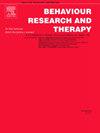Efficacy and mediators of online cognitive therapy for taboo obsessions in adults with obsessive-compulsive disorder: Randomized controlled trial
IF 4.2
2区 心理学
Q1 PSYCHOLOGY, CLINICAL
引用次数: 0
Abstract
Taboo obsessions are ego-dystonic, recurrent, and intrusive thoughts involving aggressive, sexual and/or religious themes, which are common in individuals with obsessive-compulsive disorder (OCD). These symptoms are often challenging to treat with traditional, exposure-based approaches. Our research group has developed and successfully piloted an Internet-delivered intervention based on the cognitive framework of taboo obsessions (I-CT). The current randomized controlled trial evaluated the efficacy of I-CT compared to Internet-delivered general psychological support in reducing OCD symptom severity and associated impairments. A secondary aim was to investigate if the treatment effect was mediated by a reduction in negative appraisals, the proposed mechanism of change in cognitive therapy. Sixty-eight participants with a diagnosis of OCD and primary taboo obsessions were randomized to either I-CT or general psychological support for 8 weeks. The primary outcome was change on the clinician-rated Yale-Brown Obsessive-Compulsive Scale (Y-BOCS), administered by masked assessors at pre- and post-treatment. Participants in both groups had a significant reduction of OCD symptom severity but those randomized to I-CT had significantly better outcomes (between group bootstrapped d = 0.69, [95% CI, 0.22–1.17]). The proportion of participants classed as responders and remitters was also higher in the I-CT group (odds ratio 2.33 and 1.77 respectively), though not significantly. A large portion of the treatment effect (55%) was mediated by change in negative appraisals. I-CT could be a promising treatment approach for individuals with taboo obsessions who do not wish, or are unable, to engage in, or do not respond to, exposure-based treatment for OCD.
在线认知疗法治疗成人强迫症禁忌强迫症的疗效及影响因素:随机对照试验
禁忌性强迫症是指涉及攻击性、性和/或宗教主题的自我失调、反复发作和侵入性的想法,在强迫症(OCD)患者中很常见。这些症状往往难以用传统的、基于暴露的方法治疗。我们的研究小组已经开发并成功试点了一种基于禁忌强迫症认知框架的互联网干预方法(I-CT)。目前的随机对照试验评估了I-CT与互联网提供的一般心理支持在减少强迫症症状严重程度和相关损伤方面的疗效。第二个目的是调查治疗效果是否由负面评价的减少介导,这是认知治疗中提出的改变机制。68名诊断为强迫症和原发性禁忌强迫症的参与者被随机分配到I-CT或一般心理支持组,为期8周。主要结果是临床医生评定的耶鲁-布朗强迫症量表(Y-BOCS)的变化,该量表由蒙面评估员在治疗前和治疗后进行管理。两组参与者的强迫症症状严重程度均显著降低,但随机分配到I-CT组的结果明显更好(组间差异d = 0.69, [95% CI, 0.22-1.17])。在I-CT组中,应答者和缓解者的比例也更高(优势比分别为2.33和1.77),尽管差异不显著。治疗效果的很大一部分(55%)是由负面评价的改变介导的。对于那些有禁忌性强迫症的人来说,I-CT可能是一种很有希望的治疗方法,这些人不希望或无法参与或对基于暴露的强迫症治疗没有反应。
本文章由计算机程序翻译,如有差异,请以英文原文为准。
求助全文
约1分钟内获得全文
求助全文
来源期刊

Behaviour Research and Therapy
PSYCHOLOGY, CLINICAL-
CiteScore
7.50
自引率
7.30%
发文量
148
期刊介绍:
The major focus of Behaviour Research and Therapy is an experimental psychopathology approach to understanding emotional and behavioral disorders and their prevention and treatment, using cognitive, behavioral, and psychophysiological (including neural) methods and models. This includes laboratory-based experimental studies with healthy, at risk and subclinical individuals that inform clinical application as well as studies with clinically severe samples. The following types of submissions are encouraged: theoretical reviews of mechanisms that contribute to psychopathology and that offer new treatment targets; tests of novel, mechanistically focused psychological interventions, especially ones that include theory-driven or experimentally-derived predictors, moderators and mediators; and innovations in dissemination and implementation of evidence-based practices into clinical practice in psychology and associated fields, especially those that target underlying mechanisms or focus on novel approaches to treatment delivery. In addition to traditional psychological disorders, the scope of the journal includes behavioural medicine (e.g., chronic pain). The journal will not consider manuscripts dealing primarily with measurement, psychometric analyses, and personality assessment.
 求助内容:
求助内容: 应助结果提醒方式:
应助结果提醒方式:


